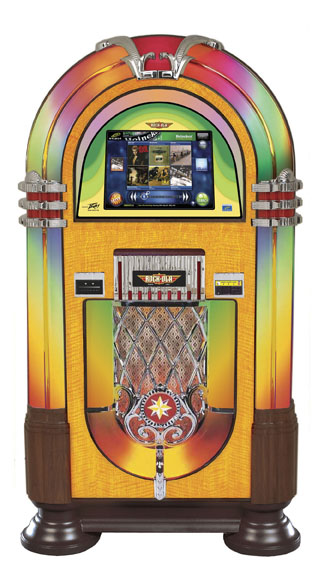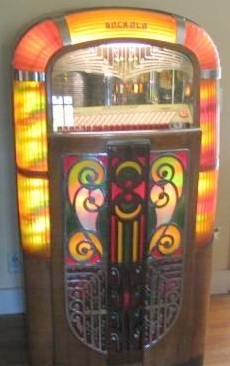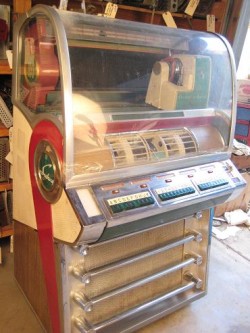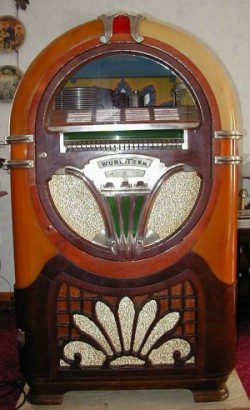Jukebox History 1927-2008.
history Of the jukebox
\r\n\r\nthe jukebox is partially automated music playing device usually coin operated machine that can play specially selected songs from the separately stored content. The traditional jukebox is rather large with a rounded top and colored lighting at the top of the machine on its vertical sides. The classic jukebox has buttons with signatures and numbers on them that, when together are used to select a specific song from the list.
\r\n\r\nCoin-operated music boxes and playing the piano was installed on the Fairgrounds to play tunes for money, amusement parks and other public places (such as train stations in Switzerland) a few decades before the introduction of reliable coin-operated phonograph. The first jukebox was an automatic phonograph produced in 1927 Rowe International, then known as AMI. Some of these automatic musical instruments were extremely well built and have survived to this day in the hands of collectors and museums. But commercially they could not compete with the music machines in the end, as they were limited by the tool (or tools) used in their construction, and could not reproduce the human voice. The immediate ancestor of the jukebox, called "Coin-slot phonograph", was the first recording, which was presented to the public before it was launched mass production of home audio equipment . Such machines began to be mass-produced since 1889, using phonograph cylinders for records. The earliest machines played only one song (approximately 2 minutes of music or entertainment), but soon devices were developed that allowed customers to choose from a variety of compositions. In the 1910's, the cylinder is gradually replaced by the gramophone record. The term "juke box " came into use in the United States in the 1930s, which occurred anyway because of the African American slang "jook" means "dance" or from the name given to it by critics who predicted that it would encourage criminal activities of the fake names the Juke. In 1950 phonograph records at 78 rpm equipped with almost all jukeboxes, until one day Seeburg Corporation used in all machines records 45 rpm.
In the 1960s and ' 70s in restaurants was the most popular jukeboxes wall design. The most famous is the Seeburg 3W1. In the wall machines were not recording mechanism inside; instead, they accept coins and chose the tunes that has been played a jukebox or remote unit elsewhere. A big box was set in the next room with a control inside, 160 songs (Rock-Ola and Wurlitzer) or 200 songs (Seeburg) were available to the client. Small speakers in the wallbox only played Some jukeboxes during this time were able to play special 33 1/3 disk rpm, which was the same diameter as the plates on 45 rpm, so it was possible to reproduce a longer song for the higher price.Wurlitzers were unique because they could lose 2 side of the plate at the same time;Rock-Ola and Seeburg first played all of the selected parties And, then, all parties.
\r\n\r\nStarting in the 1980s, CDs have become the norm for modern jukeboxes. By the end of the 20th century, several companies began to produce fully digital jukeboxes which did not use CDs, downloading the tunes directly from the Internet or via a dedicated phone line. In addition to automatically downloading a potentially larger number of songs than what is available on CD-ROM in previous models, the digital jukeboxes were sending information back about what is played, and where, opening up new commercial opportunities. Jukeboxes and their predecessors were very popular from the 1890s. They were the most popular from the 1940s until the mid-1960s, especially in the 1950s. Today, they are often associated with early rock ' n ' roll, but was very popular in the swing music era as well. As a result, the shops and restaurants in a retro theme, such as chain Johnny Rockets, have in each institution a jukebox.
\r\n\r\n\r\n\r\n
\r\n\r\n
 FAMOUS MODEL
FAMOUS MODEL
-Rock-Ola model 1413 Premier (1942) - it resembles something from a science fiction movie. It has a distinctive blue-green glowing "eye globe" in the lower-middle of its gill-like grille.
\r\n\r\n-Rock-Ola model 1422 and 1426 (1946-47) - Beautiful use of rainbow-colored leafy-spiral grill-work resembling violin stems.
\r\n\r\n-1953 Seeburg M100C - This machine played 50 45 rpm records making it a 100 play. Mirrors on the inside rotating animation in the pilasters. Chrome glass tubes in the front, very colorful.
\r\n\r\n-1954 Rock-Ola 1438 Comet - This was the first 45 RPM Record machine that Rockola offered Exclusively as 45 rpm only. It played 60 45 rpm records (120 Selection) It seemed to copy a lot of features from the Seeburg M100C (Pilasters) Curved glass but still had a personal style that many people enjoyed.
\r\n\r\n-1954 Seeburg HF100R - This machine played 50 45 rpm records. Featured glass Icicle panels and chrome on the grill. It had a bandshell appearance with anodized chrome. It had 5 speakers to give the listener better sound "all around the Jukebox"
\r\n\r\n-1962 Rock-Ola Princess - The name is applied to several different models that vary drastically in appearance. This model is popular today for nostalgic use in homes due to its compact size. The most desirable Princess model has a visible mechanism, something nearly universally desired by home jukebox owners.
\r\n\r\n-Wurlitzer Model 750 and 750E (1941) - In some ways a precursor to the famous 1015, but with a rounder look.
-the Wurlitzer Model 800 (1941) - Very bold looking model that in some ways it resembles a shuttle launch with its two side rockets. A flame-like glimmer was created by the internal rotating tubes casting waving shadow patterns against the lights.
\r\n\r\n-the Wurlitzer Model 850 (1941) - Some of the most artistic grille work. The highlight was a revolving polarizer peacock color animation.
\r\n\r\n-the Wurlitzer Model 950 (1942) - In some ways a visual hybrid between models 800 and 1015. -Black metal edging gives this a look reminiscent of ancient Greek design.
\r\n\r\n-the Wurlitzer Model 1015 (1948) - Considered by many to be the universal design for a jukebox. This is the model with the color-changing columns and bubble tubes and the arching top. Reproductions of this version are made by many commercial jukebox manufacturers to this day. The original played 78 rpm records, but it is available today with CD, 45, and even digital download.
\r\n\r\n-the Wurlitzer Models 1080 and 1080-A (1947-48) - Another model that seems to have heavy Greek influence. This model was not as colored-light intensive of other models of the era, but makes very stylish use of wood and classical curves.
\r\n-Wurlitzer Jukebox Model 1100 (1948-49) - Represents a transition style between the 40s and 50s jukebox styling when the record player area started opening up behind larger glass displays. Heavy use of chrome styling.
-AMI "Top Flight" Model (1936-38) - Very distinctive grille-work with a sleek, metallic Sci-Fi feel. (Produced by Rowe International, then known as AMI)
\r\n\r\n-AMI Model "A" Jukebox of (1946-47) - Unique "space helmet" look. In many ways the styling was ahead of its time. The model A was also the first jukebox to play both side of every record. It held 20 78-rpm discs and offered patrons 40 selections. (Produced by Rowe International, then known as AMI)
\r\nSeeburg Model "G" This Jukebox is known as the "Happy Days Machine" As it was used in the sit com Happy Days. It was 100 play and features chrome pilasters.
-AMI Model "G" Jukebox of (1954) - Has the look of a "Fish Tank" and has been named so. This was the first machine to use a folded horn concept speaker system (Produced by Rowe International, then known as AMI)
\r\n\r\n-AMI Model H, I, J and K All of these models had the 50's car windshield look. (eg: 1958 Plymouth front windshield [wrap around]) This was a new concept and currently people in Europe grab these machines as fast as they can. Last year for this style for AMI was 1960 and was the model K. The model I remains at this time time the MOST desirable machine to own. (Produced by Rowe International, then known as AMI)
\r\n\r\n-AMI Continental - Often compared to the Jetsons' car, this model has  the selections on a curved vertical board. The mechanism is visible through a clear dome on the top of the main body. This model is especially popular today in Europe.
the selections on a curved vertical board. The mechanism is visible through a clear dome on the top of the main body. This model is especially popular today in Europe.
\r\muzykalnyi machine with an American roots
the Company "Rock-Ola" produces music machines and musical machines. We believe that we are doing the best jukeboxes in the world!
